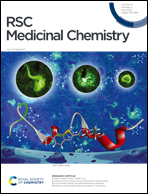Synthesis and structure–activity relationship (SAR) studies of 1,2,3-triazole, amide, and ester-based benzothiazole derivatives as potential molecular probes for tau protein†
Abstract
The pyridinyl-butadienyl-benzothiazole (PBB3 15) scaffold was used to develop tau ligands with improved in vitro and in vivo properties for imaging applications to provide insights into the etiology and characteristics of Alzheimer's disease. The photoisomerisable trans-butadiene bridge of PBB3 was replaced with 1,2,3-triazole, amide, and ester moieties and in vitro fluorescence staining studies revealed that triazole derivatives showed good visualisation of Aβ plaques, but failed to detect the neurofibrillary tangles (NFTs) in human brain sections. However, NFTs could be observed using the amide 110 and ester 129. Furthermore, the ligands showed low to high affinities (Ki = >1.5 mM–0.46 nM) at the shared binding site(s) with PBB3.



 Please wait while we load your content...
Please wait while we load your content...